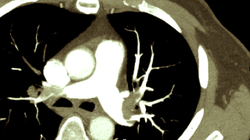 According to the American College of Chest Physicians (ACCP) guidelines thrombolytic therapy is not recommended for most patients (grade 1B). One reason is that controlled clinical trials have not demonstrated benefits in term of reduced mortality rates or earlier resolution of symptoms when currently compared with heparin. Another reason is that thrombolysis with tPA carries a substantial risk for severe complications like intracerebral haemorrhage. Currently accepted indications for thrombolytic therapy include hemodynamic instability or right ventricular dysfunction demonstrated on echo. Although not scientifically proven, quite a few cardiologists will argue that thrombolysis will benefit in better clinical long term outcome by experience. The question remains whether thrombolysis is underutilized and might improve outcomes in moderate PE’s as well. In this publication in Clinical Cardiology Mohsen at al. present an interesting concept of applying a ‘safe dose thrombolysis’ (SDT) where half the dose of tPA is given in conjunction with a modified dose of parenteral anticoagulation... rivaroxaban in this case. Over 12 months 98 patients with moderate to severe PE were treated with this regimen. They come to the conclusion that safe dose thrombolysis plus rivaroxaban was highly safe (no bleeds, recurrent VTE in 3 patients) and effective, leading to favorable early and intermediate-term outcomes and early discharge. Despite some limitations in this publication the idea is interesting indeed and might be a first step towards a new approach towards thrombolysis. Sharifi M et al. Clin Cardiol. 2014 Feb;37(2):78-82 Comments are closed.
|
Search
|


 RSS Feed
RSS Feed


